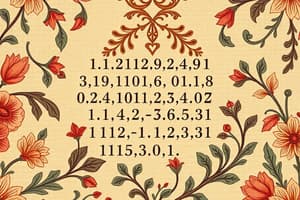Podcast
Questions and Answers
The plus sign (+) is used for subtraction in arithmetic operations.
The plus sign (+) is used for subtraction in arithmetic operations.
False (B)
Multiplication involves adding two numbers together.
Multiplication involves adding two numbers together.
False (B)
If x = 5 and y = 2, the result of x * y is 10.
If x = 5 and y = 2, the result of x * y is 10.
True (A)
Division in arithmetic operations gives the remainder, not the quotient.
Division in arithmetic operations gives the remainder, not the quotient.
The minus sign (-) represents multiplication in arithmetic operations.
The minus sign (-) represents multiplication in arithmetic operations.
Flashcards are hidden until you start studying
Study Notes
Operators
An operator is a symbol used to perform a specific mathematical operation on operands. There are several types of operators, including arithmetic operators, comparison operators, logical operators, assignment operators, bitwise operators, and conditional operators. In this article, we will focus on arithmetic operators.
Arithmetic Operators
Arithmetic operators perform basic operations related to numbers such as addition, subtraction, multiplication, division, and modulus. Here's how they work:
Addition (+)
The plus sign (+) represents the operation of adding two values together. For example, if you have two variables x and y, with x = 5 and y = 7, their sum can be calculated using the following code:
sum = x + y
print(sum)
Output:
12
The result is 12.
Subtraction (-)
The minus sign (-) represents the operation of taking away one value from another. Continuing with our previous examples, by subtracting y from x, this calculation would return 2:
difference = x - y
print(difference)
Output:
2
The result is 2.
Multiplication (*)
Multiplication involves multiplying two numbers. If x = 5 and y = 7, their product can be calculated as follows:
product = x * y
print(product)
Output:
35
The result is 35.
Division (/)
Dividing one number by another gives the quotient. Using x = 10 and y = 2, the result is 5:
quotient = x / y
print(quotient)
Output:
5
The result is 5.
Modulo (% or %%)
Modulo returns the remainder when one number is divided by another. Given x = 10 and y = 3, the result is 1:
remainder = x % y
print(remainder)
Output:
1
The result is 1.
These arithmetic operators play a crucial role in performing different kinds of calculations involving numbers.
Studying That Suits You
Use AI to generate personalized quizzes and flashcards to suit your learning preferences.





